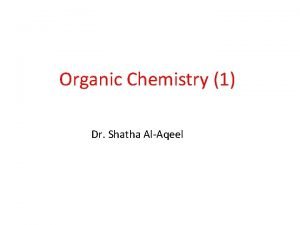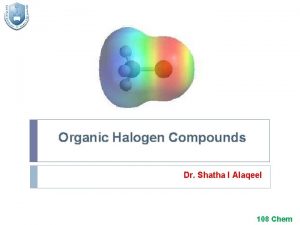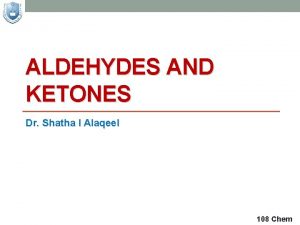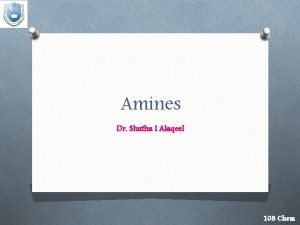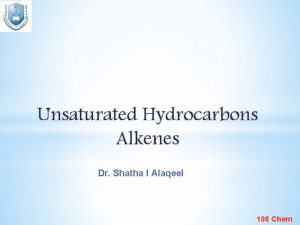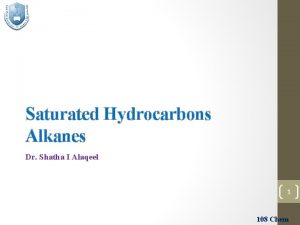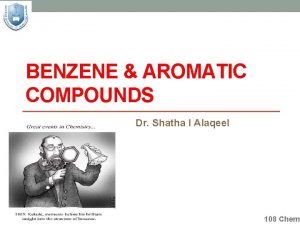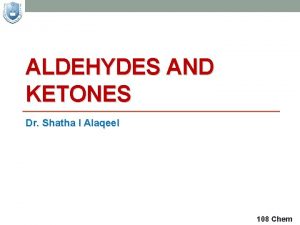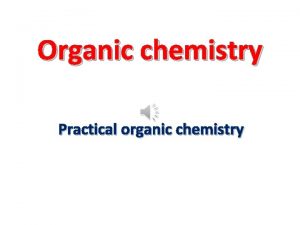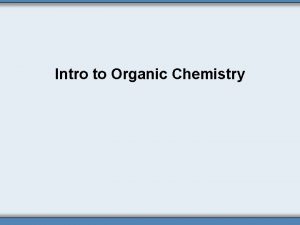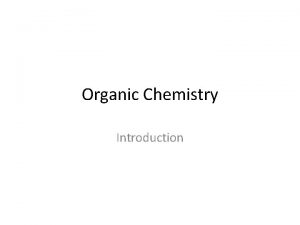1 Introduction to Organic Chemistry Dr Shatha Alaqeel



























- Slides: 27

1 Introduction to Organic Chemistry Dr. Shatha Alaqeel Chem. 108

2 Leaning objectives: By the end of this lecture the student will know: § What is Organic Chemistry? § How are organic compounds are made from indiviual elements? § Types of bond in organic compounds and their significance § Different methods of representing chemical bonding

3 What is organic chemistry? § Organic chemistry is the study of carbons / hydrogen containing compounds and their derivatives (containing other elements such as O, X and N). § organic chemistry also is the study of the chemistry of life.

4 Importance of organic compounds § DNA: the giant molecules that contain all the genetic information for a given species. § proteins: blood, muscle, and skin. § Enzymes: catalyze the reactions that occur in our bodies. § Petroleum: furnish the energy that sustains life. § Polymers: Cloths, cars, plastic. § Medicine

5 Chemical Bonds ØThe attractive force which holds together the constituent particles (atoms, ions or molecules) in chemical species is known as chemical bond. ØEach bond is made up of two electrons ØThe electrons that participate in chemical bonds are the valence electrons, which are the electrons found in an atom's outermost shell.

Review of Valence Electrons Number of valence electrons of a main (A) group atom = Group number

7 Chemical Bonding 1. Ionic Bonds 2. Covalent Bonds 3. Coordinate Covalent Bonds

8 Ionic bond ØIonic compounds are formed when one atom gains a valence electron from a different atom, forming a negative ion (anion) and a positive ion (cation) respectively. The electrostatic force of attraction between oppositely charged ions constitutes the ionic bond. Therefore ionic bonds are usually between metals and nonmetals ; opposite ends of the periodic table. ØWhen two atoms with large different electronegativity values

9 Sodium lets Chlorine use its valance electron

The type of bond can usually be calculated by finding the difference in electronegativity of the two atoms that are going together.

11 Covalent Bond results when two or more atoms have similar electronegativities, lend to form bond by sharing electron pairs rather than completely transferring electrons. A covalent bond is formed when two atoms share one or more electron pairs. Covalent bonds form between two non-metal atoms.

12 Covalent Bonds: 1. single or multiple A covalent bond in which one electron pair is shared by two at oms, represented in chemical formulas by one line or two vertical dots, as C–H or C: H. A double covalent bond is where two pairs of electrons are shared between the atoms rather than just one pair, represented in chemical formulas by two lines or four vertical dots, as O=O or O: : O. A triple covalent bond is where three pairs of electrons are shared between the atoms rather than just one pair, represented in chemical formulas by three lines or sex vertical dots

13

14 2. polar or non polar Ø Polar covalent bond Covalent bonds can be formed not only between identical atoms but also between different atoms (C-H, C-Cl), Provided that the atoms do not differ too greatly in electronegativity. However, one of the atoms partially "pulls" the bonding electrons toward itself, creating an unequal sharing of those bonding electrons. the electron pair may not be shared equally between them. Alternatively, a partial charge, written as δ+ or δ –. Ø Non polar If the bonding electrons are shared equally because both atoms have the same electronegativity.

15 2. polar or non polar

16 Coordinate Covalent Bond § There are molecules in which one atom supplies both electrons to another atom in the formation of a covalent bond. Ammonia Lewis base Hydrogen ion Ammoniom ion Lewis acid furnishes electron pair accepts electron pair

17

18 Chemical bonding in Molecules by Lewis (electron dot) structures 1. The symbol of the element is written first. This represents the nucleus of the element with all the inner electrons that do not take part in the bond formation. 2. The valence electrons (electrons in the OUTERMOST energy level ) are then written as dots or small cross marks around the symbol. They are spread in a pair on four sides of the symbol. 3. In case of ions the charge is shown with the symbol

19 Examples: B 5 its electronic configuration is 1 s 2 2 p 1; so the outer energy level is 2, with 3 valence electrons These can be represented by Lewis structure. § Used to show an element and the number of valence electrons. § Q 1: Draw Lewis structure for Cl

20 Types of valence electrons Valence electrons of an atom which are shared with others are called BOND PAIRS and those are unshared are called LONE PAIRS (LP).

21 Covalence Numbers How Many Bonds to an Atoms? number of bonds = (full valence shell VS) – (number of valence electrons VE) (for a neutral atom) Atoms full number VS number of VE No. Typical bonds No. Typical unbonds H 2 1 1 0 C 8 4 4 0 N 8 5 3 2 O 8 6 2 4 F, Cl, Br, I 8 7 1 6

22 Condensed structural formulas

23

24 Functional Groups § Functional groups – is areactive portion of an organic molecule, an atom, or group of atoms that confers on the whole molecule its characteristic properties.

25

26

27 Thank You for your kind attention ! Questions? Comments
 Functional groups ib chemistry
Functional groups ib chemistry Inorganic vs organic chemistry
Inorganic vs organic chemistry Intro to organic chemistry
Intro to organic chemistry Cycloalkanes
Cycloalkanes Chemistry of soap making
Chemistry of soap making Ester organic chemistry
Ester organic chemistry But-1-ene to but-2-ene
But-1-ene to but-2-ene Rearranged most stable carbocation is
Rearranged most stable carbocation is Ee organic chemistry
Ee organic chemistry Ario organic chemistry
Ario organic chemistry Pericyclic
Pericyclic David klein organic chemistry 3rd edition
David klein organic chemistry 3rd edition Organic chemistry 2nd edition klein
Organic chemistry 2nd edition klein Leveling effect organic chemistry
Leveling effect organic chemistry How to name compounds in organic chemistry
How to name compounds in organic chemistry Organic chemistry lab report example
Organic chemistry lab report example Www.masterorganicchemistry.com
Www.masterorganicchemistry.com Organic chemistry grade 10
Organic chemistry grade 10 Cyclo organic chemistry
Cyclo organic chemistry Kiliani fischer synthesis
Kiliani fischer synthesis Meth eth prop but pent hex
Meth eth prop but pent hex Fractional distillation of petroleum
Fractional distillation of petroleum What is chemistry
What is chemistry Organic chemistry myanmar
Organic chemistry myanmar Ch3co+ electrophile name
Ch3co+ electrophile name Gc organic chemistry
Gc organic chemistry Hono organic chemistry
Hono organic chemistry Geminal and vicinal
Geminal and vicinal




























